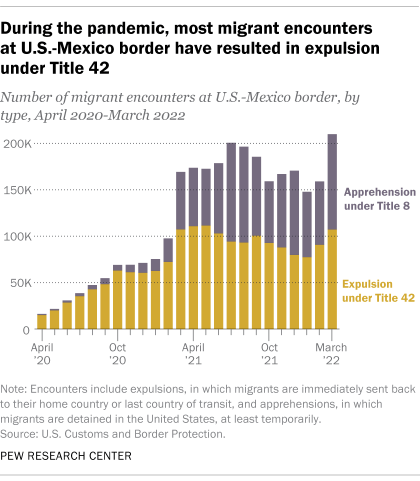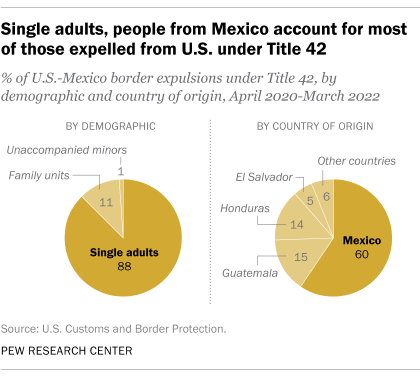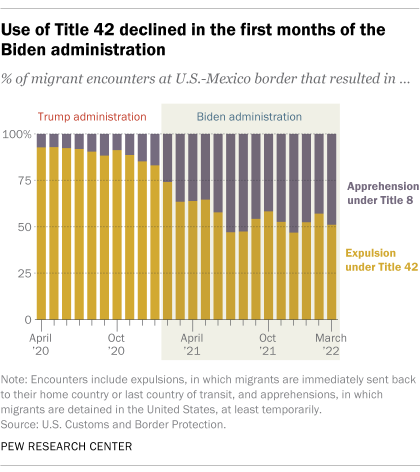The Biden administration is seeking to end the use of Title 42, a pandemic-era policy that has led the Border Patrol to turn away hundreds of thousands of migrants attempting to enter the United States at the U.S.-Mexico border over the past two years. The administration’s move to end the Title 42 policy has been cheered in some corners and criticized in others, and opponents of the decision are challenging it in court and in Congress.
As the debate over the use of Title 42 unfolds, here are answers to key questions about the policy, based primarily on information from the Centers for Disease Control and Prevention (CDC) and Customs and Border Protection (CBP), the agency that oversees the Border Patrol.
This Pew Research Center analysis examines the immigration policy known as Title 42, which the Biden administration is seeking to end by May 23, 2022. The analysis is based primarily on information from the Centers for Disease Control and Prevention (CDC) and Customs and Border Protection (CBP), the agency that oversees the Border Patrol.
The Border Patrol provides statistics on migrant “encounters” at the U.S.-Mexico border. Encounters refer to two distinct kinds of events: expulsions under Title 42, in which migrants are immediately expelled to their home country or last country of transit, and apprehensions under Title 8, in which migrants are detained in the United States, at least temporarily.
It is important to note that encounters refer to events, not people, and that some migrants are encountered more than once. In fact, repeat border crossers have accounted for around a quarter of total encounters at U.S. borders in recent years. As a result, the number of encounters overstates the number of distinct individuals involved.
This analysis only includes encounters reported by the U.S. Border Patrol at the U.S.-Mexico border. It excludes encounters reported by the Office of Field Operations and those at the U.S.-Canada border.
What is Title 42?
Title 42 refers to a rarely used section of the U.S. Code that dates to 1944. The law empowers federal health authorities to prohibit migrants from entering the country if it is determined that doing so could prevent the spread of contagious diseases.
The CDC invoked Title 42 at the beginning of the U.S. coronavirus outbreak in March 2020, giving Border Patrol agents the authority to swiftly expel migrants trying to enter the U.S. instead of allowing them to seek asylum within the country, as had long been the policy before the pandemic. Migrants expelled from the U.S. under Title 42 are returned to their home country or most recent transit country.
Part of the rationale for invoking Title 42 was to avoid holding migrants in crowded U.S. immigration facilities as the highly transmissible coronavirus was spreading. But some advocates, elected officials and others have criticized the policy as more of an effort to restrict immigration to the U.S. than a public health strategy.
Why is the Biden administration seeking to end the use of Title 42?
In announcing its decision to end the policy after more than two years, the CDC cited “current public health conditions and an increased availability of tools to fight COVID-19,” including vaccines that can be distributed to migrants who are arriving at the border.
The Biden administration had initially planned for the policy to end on May 23, but a federal judge and members of Congress are considering putting that plan on hold amid concerns that the decision could lead to a surge in migration in the weeks and months ahead.
The CDC already ended the use of Title 42 for one group of migrants – unaccompanied minors – in March. It is currently seeking to end the policy for two other groups of migrants: single adults and people traveling in families.
What is the alternative to Title 42?
Before the CDC invoked Title 42, the Border Patrol handled migrants under a separate section of the U.S. Code known as Title 8, which deals with border enforcement.
Under Title 8, migrants typically can seek asylum in the U.S., citing a credible fear of persecution or other threats in their home country. The Biden administration has said that it would return to Title 8 enforcement practices after the Title 42 policy ends. (This infographic from the Congressional Research Service shows how immigration enforcement practices work under both Title 8 and Title 42. The Border Patrol has relied on both approaches during the pandemic.)
A return to pre-pandemic enforcement practices does not necessarily mean that migrants would be allowed to enter and remain in the country. Many of them would need to wait in Mexico until their asylum claims can be decided – the result of a Trump administration policy that the Biden administration has kept in place under court order.
Migrants who cannot establish a legal claim to remain in the country would face removal from the U.S. and potentially other penalties. For example, those who are repeatedly caught attempting to enter the U.S. without authorization could be prosecuted criminally, as they frequently have been in the past.
How has immigration enforcement at the U.S.-Mexico border changed in the era of Title 42?
The Border Patrol tracks migration patterns at the southwestern border through a metric known as “encounters.” The term refers to two distinct kinds of events: expulsions, in which migrants are immediately removed from the U.S. under Title 42, and apprehensions, in which migrants are detained in the U.S., at least temporarily, under Title 8.
The Border Patrol has retained some discretion over whether to process migrants under Title 42 or Title 8, but most encounters during COVID-19 have ended in expulsion under Title 42.

Overall, there were nearly 2.9 million encounters with migrants along the U.S.-Mexico border between April 2020, the first full month after Title 42 went into effect, and March 2022, the most recent month with available data. Nearly 1.8 million of those encounters, or 61%, resulted in migrants being expelled under Title 42. The roughly 1.1 million remaining encounters ended in migrants being apprehended under Title 8.
It’s important to note that while the number of migrant encounters has risen sharply during the pandemic, the number of individuals encountered is considerably lower. That’s because around a quarter of migrant encounters at U.S. borders during the pandemic have involved repeat crossers. By contrast, in the fiscal year immediately preceding the pandemic, only 7% of migrant encounters involved repeat crossers. Title 42 may have contributed to the increase in repeat border crossers during COVID-19 since those who are expelled from the U.S. under the policy can try to enter the U.S. again without being subject to certain penalties they might otherwise face under Title 8.
Who has been expelled from the country under Title 42?

Almost nine-in-ten of the nearly 1.8 million expulsions that have taken place under Title 42 since April 2020 have involved single adults, while the remainder have involved people traveling in families (11%) or unaccompanied minors (1%).
Mexico is by far the most common origin nation of those who have been expelled under Title 42. Six-in-ten of those who have been expelled under Title 42 have been from Mexico, while 15% have been from Guatemala, 14% have been from Honduras, 5% have been from El Salvador and 6% have been from other countries.
How did the use of Title 42 change from the Trump administration to the Biden administration?

Both administrations leaned heavily on Title 42 in their immigration enforcement practices at the U.S.-Mexico border during the pandemic. But the Trump administration did so more than the Biden administration, at least when looking at the percentage of all encounters that ended in expulsion from the country under Title 42.
Under the Trump administration, 80% or more of monthly migrant encounters at the U.S.-Mexico border resulted in expulsion from the U.S. under Title 42. That percentage declined under Biden, who had pledged during his campaign for the White House to reverse some of Trump’s immigration policies. Even during the Biden administration, however, Title 42 expulsions have remained common: In March 2022, 51% of all migrant encounters at the southwestern border ended in expulsion under Title 42.
